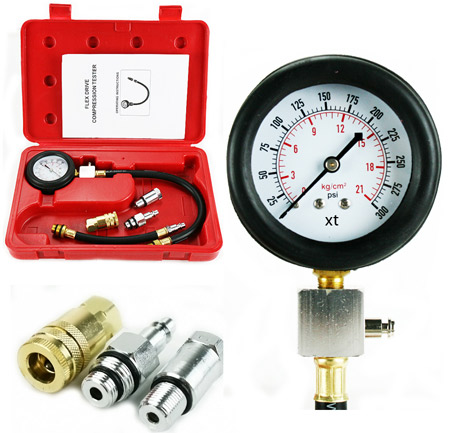The compression of your bike’s engine is very important. So much so that if the compression rate is not proper or if there is less compression, then engine will begin to misfire and will not start. And then no amount of carburetor cleaning or anything is going to help it out except to get the work done on the engine. Most of the times you might end up having an engine rebuild. But to know there is an issue, you will have to perform an engine compression test on the engine and that is what we are going to check out how. So here are the steps to perform an engine compression test.

By: Pratik Patole

Step 1: To perform a compression test you will need a pressure meter or a compression gauge as it is generally referred to. To put the compression gauge in the engine block you will have to remove the spark plug from the engine.
Step 2: It is always a good idea to clean up the spark plugs with compressed air to remove all the dirt particles so as to make sure they won’t fall back into the engine when fit again. And in the spark plug hole, push in the compression gauge nozzle.
Step 3: Now kick start the engine or turn the engine about 3-4 times and then check the reading on the gauge. Once you get the reading, then release the pressure and repeat the same process 3-4 times until you get a stable reading on multiple occasions.
READ ALSO: What Could Cause Loss Of Engine Compression?
Step 4: The recommended compression rate is expected to be above 100 psi. If it is less, then you might have to check out the compression rate. If it is too less, then the engine might need rebuild. If you wish to check that only the piston rings are damaged, then pour a teaspoon of oil in the engine through the hole where the spark plug fits in and check again, if the compression increases then the piston rings are fine, if not then they are broken.
Step 5: Also you can further check if the valves are out by checking the tappet clearance. If that is fine then you will have to check if the valves are leaking air. If it works out, then you are saved else you will have to get the engine rebuilt.
So this way you can perform an engine compression test and make sure that the engine is proper. Loss of compression leads to lower engine performance which fixing of any other part is not going to help out. So make sure the compression of the engine is always proper and if you feel a loss of power, then get it checked ASAP with priority before things get from bad to worse and increase the amount of repairs that need to be done.Step 2: It is always a good idea to clean up the spark plugs with compressed air to remove all the dirt particles so as to make sure they won’t fall back into the engine when fit again. And in the spark plug hole, push in the compression gauge nozzle.
Step 3: Now kick start the engine or turn the engine about 3-4 times and then check the reading on the gauge. Once you get the reading, then release the pressure and repeat the same process 3-4 times until you get a stable reading on multiple occasions.
READ ALSO: What Could Cause Loss Of Engine Compression?
Step 4: The recommended compression rate is expected to be above 100 psi. If it is less, then you might have to check out the compression rate. If it is too less, then the engine might need rebuild. If you wish to check that only the piston rings are damaged, then pour a teaspoon of oil in the engine through the hole where the spark plug fits in and check again, if the compression increases then the piston rings are fine, if not then they are broken.
Step 5: Also you can further check if the valves are out by checking the tappet clearance. If that is fine then you will have to check if the valves are leaking air. If it works out, then you are saved else you will have to get the engine rebuilt.
By: Pratik Patole











